We may receive a commission when you use our affiliate links. However, this does not impact our recommendations.
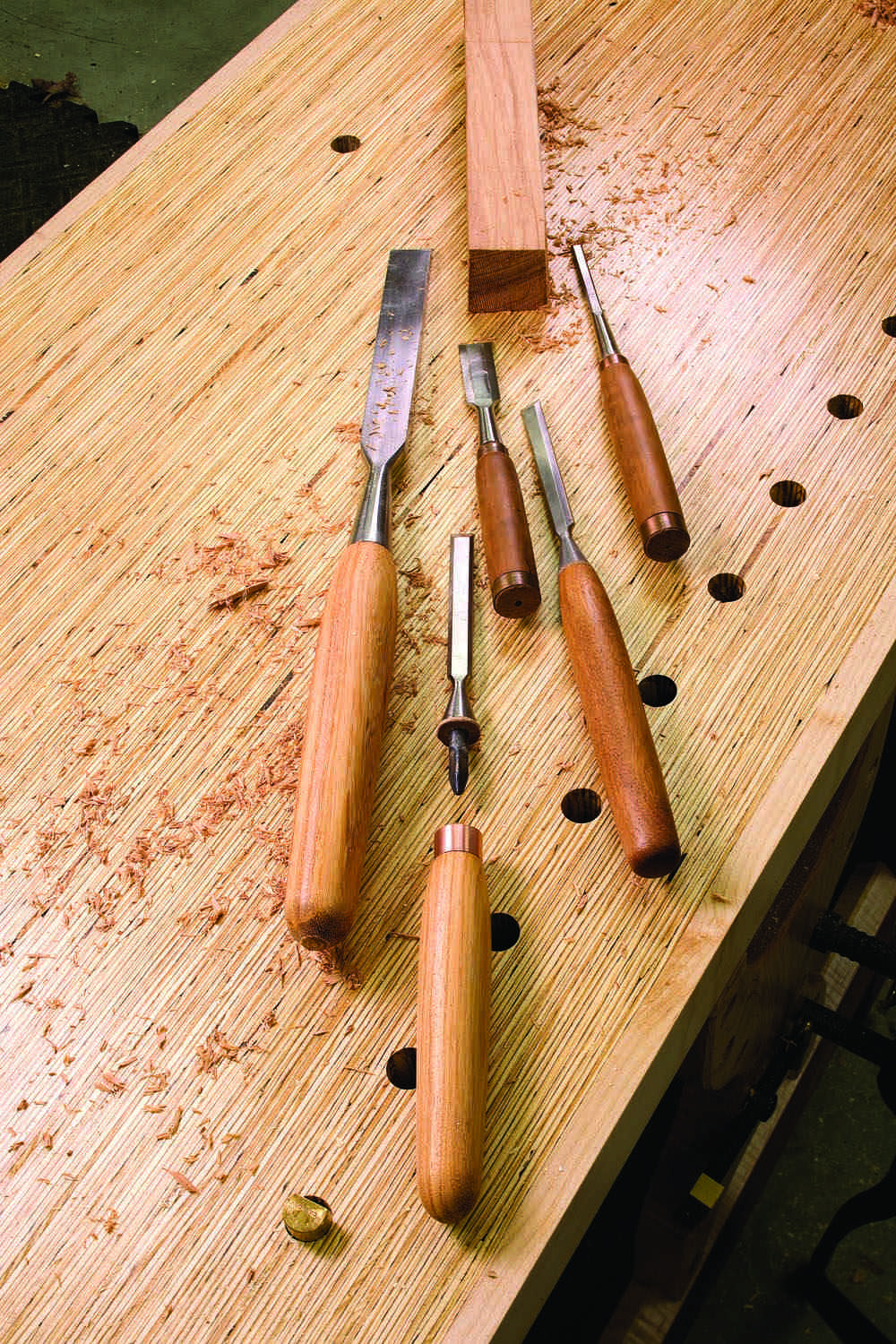
Looks good, feels good. Custom-turned handles make a big improvement in your tools; you can see and feel the difference.
Custom-fit your tools to your hand.
One of the best uses for a lathe is making tool handles. Most production tool handles leave something to be desired. The good news is that the handle is the part of tool that is the easiest to modify.
Fine gloves are sold in sizes such as 6, 7, 8 and 9. Work gloves are generally sold in dumbed-down categories such as small, medium and large. But when it comes to tool handles, one size is expected to fit all. Having custom tool handles is like having made-to-fit gloves. They feel like part of your body.
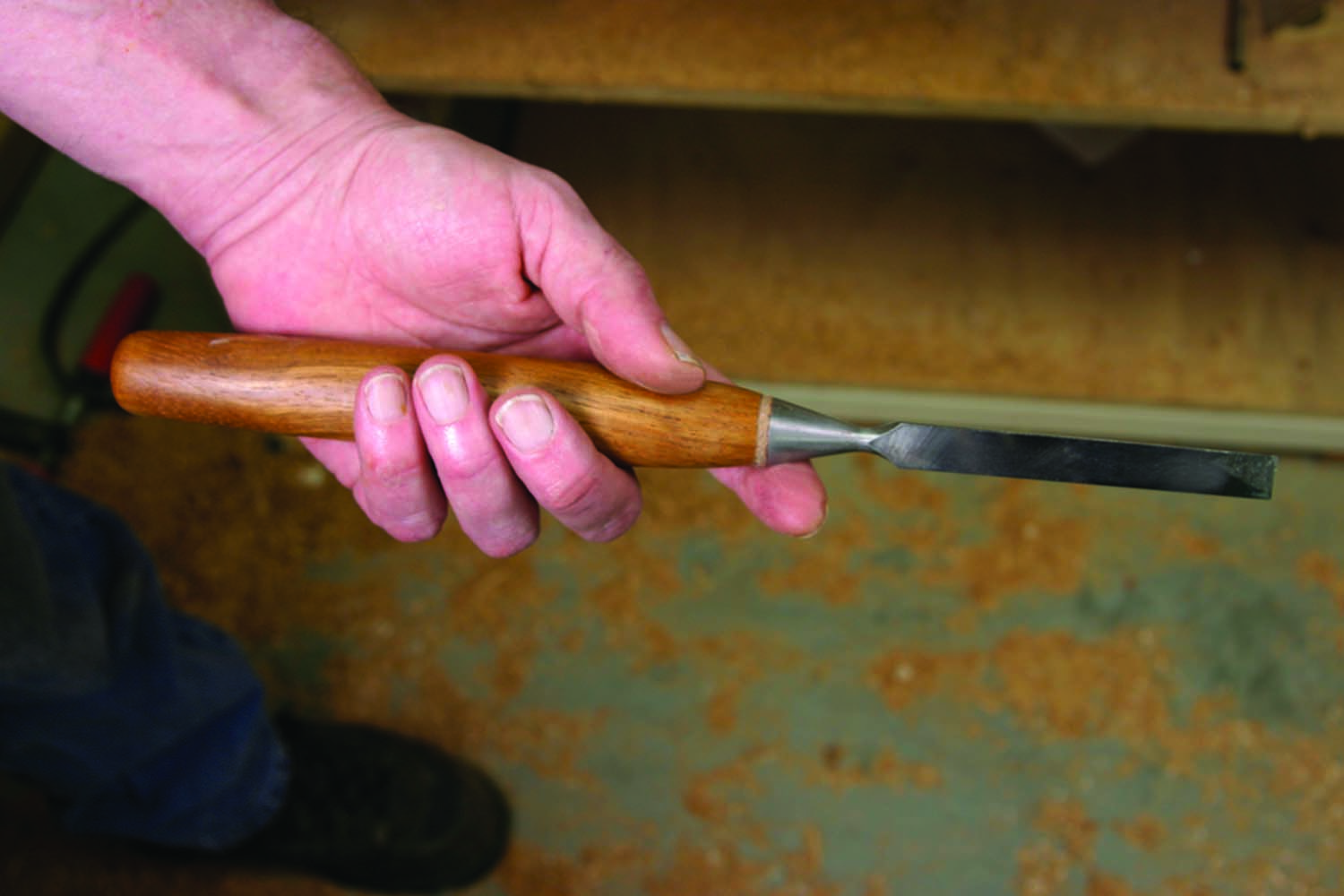
Size matters. When you make your own handles, you have control over how they fit in your hand.
Look around your shop for a tool handle that feels good to you and compare that to the rest. My guess is that the one that feels the best will be the one you reach for most often. Plastic handles are molded around the tang and very rarely loosen or come off, but I get rid of them as quickly as I can and make handles that fit my hands. Plus, I much prefer the feel of wood compared to plastic.
The lathe is best suited for making round and oval handles, or a combination of both. I, for example, prefer a turning-tool handle that is round with an oval section near the blade. The oval part allows me to use one hand or the other to torque the tool when I need to without over-gripping it to the point where I lose the tactile feedback that is so essential to successful turning.
In this article, I will outline how to turn round handles for both socket and tang chisels.
Template First
Before you make a working handle, turn a template shape that feels good in your hand without worrying about how it connects to the blade. I prefer a chisel handle that has a slight taper toward the end and toward the blade from a high point an inch or so from the blade. That allows me to lean on the tool without squeezing it to death and to keep my hand from dropping onto the shaft of the blade.
That’s true for both bench and paring chisels. The slight taper also supports a striking collar at the end of the handle to prevent the handle from splitting under hammer blows. Some woods do not really need a collar, but it’s good insurance for chopping chisels.
If, like me, you prefer longer handles for paring, then take that into consideration as well. No need to measure anything. Just play with shapes until you find one you like. Maybe you have a handle that you already like, but don’t be too sure. Play with the shapes anyway. When you find the shape you like it should fit, well, like a fine glove.
Some manufacturers size their handles, at least to some degree, according to the size of the blade; the smaller blade, the smaller the handle, but I prefer to go with the same-size handle regardless of the blade size.
Socket Handles
A socket handle relies on the taper to secure the handle to the blade by friction alone. It works the same way a Morse taper works on a lathe to secure the tooling. A good fit means that the blade won’t separate from the handle unless you want it to. That’s the theory anyway. The advantage of socket chisels is that the handle is always compressing into the socket, so a ferrule is not needed.
The hardest part is getting the fit correct, so start with a blank that is long enough to allow for some trial and error. The walls of sockets tend to get thicker as they get deeper, but that’s not always the case. This means that the inside of the socket has a different taper than the outside of the socket, but you can still use the outside of the socket to eyeball your starting point.
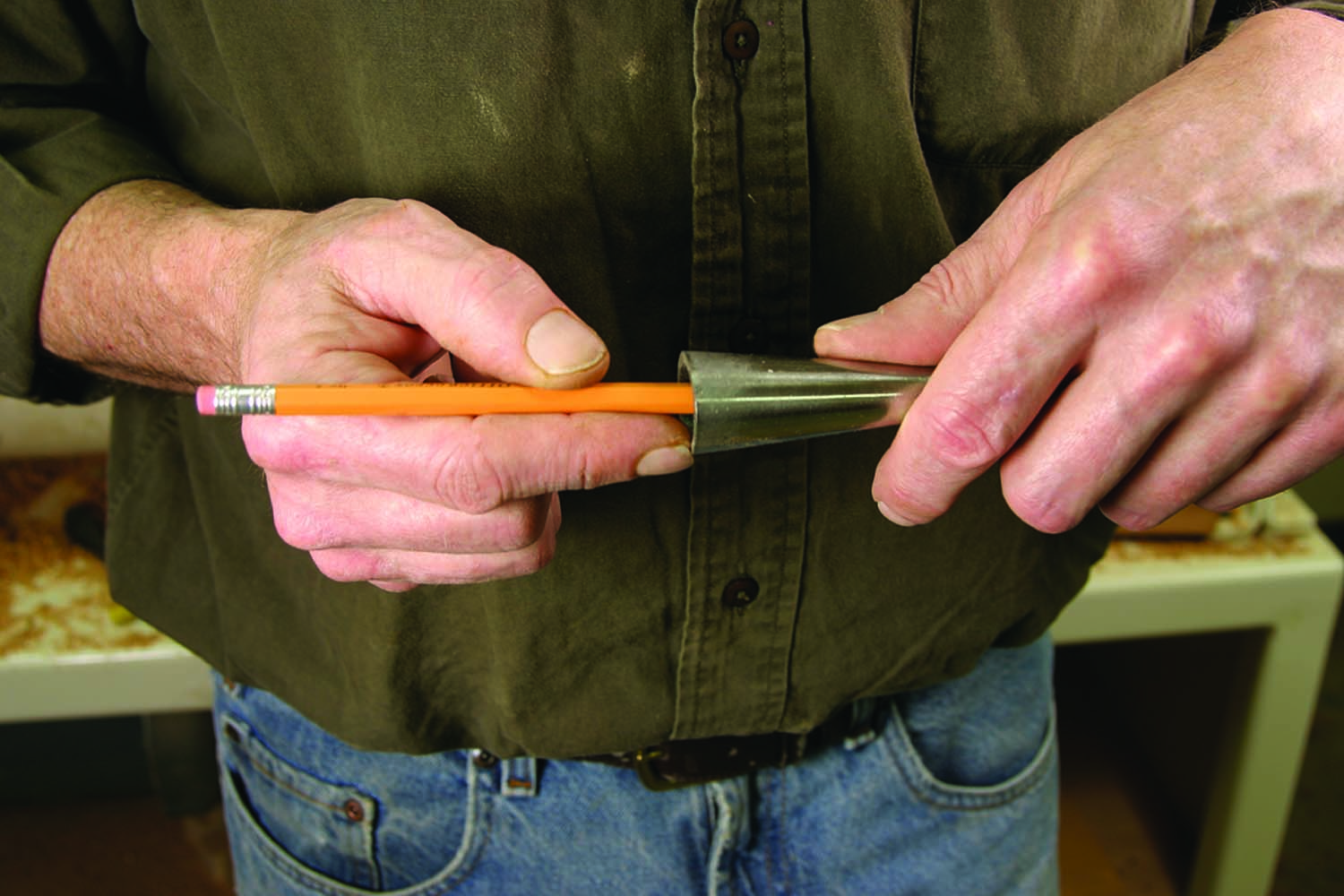
Close is close enough. Don’t be fussy with an exact measurement for the depth of the socket; use your finger or a pencil as a gauge.
To get started, round up your blank, leaving it about 1⁄4” larger than the largest diameter on your preferred handle shape. Gauge the depth of the socket with your finger or a pencil, then pull the pencil back about 3⁄16” and mark the depth of the socket on your round. This “pull back” allows the handle to settle into the socket without bottoming out.
I prefer to use a cone-shaped live center on the tailstock and I cut the socket tenon on the tailstock end. This facilitates shortening the tenon if need be while still leaving a center mark. You can trim the tenon down a little bit at a time with a parting tool or skew chisel and crank in the tailstock a bit as you go.
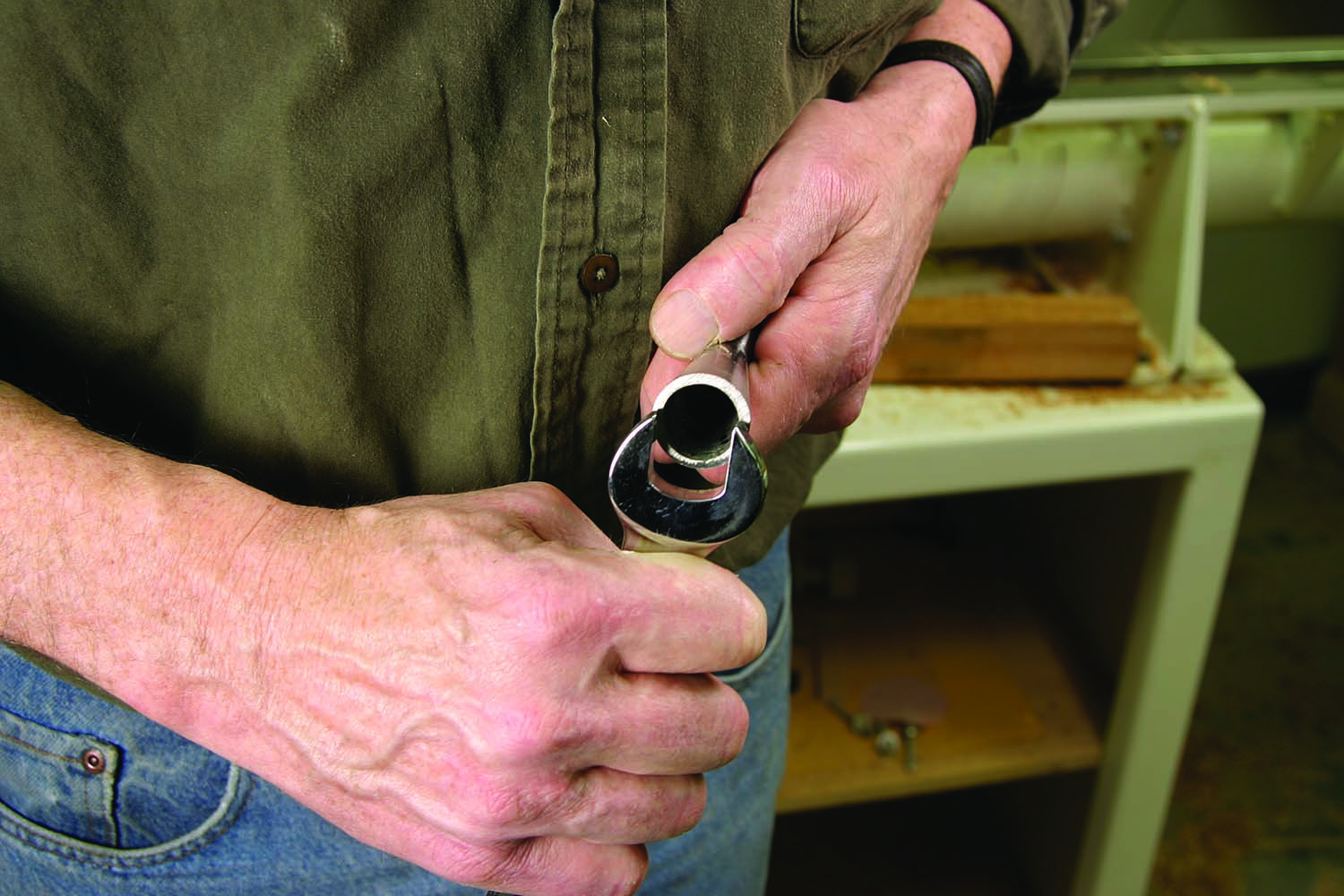
An open-ended question. Use a wrench to gauge the large diameter of the socket.
Gauge the inside diameter of the socket mouth any way you can. I use an open-end wrench to get it close. Cut a tenon roughly the size of the socket mouth using a bedan (a specialized parting tool) or a skew chisel.
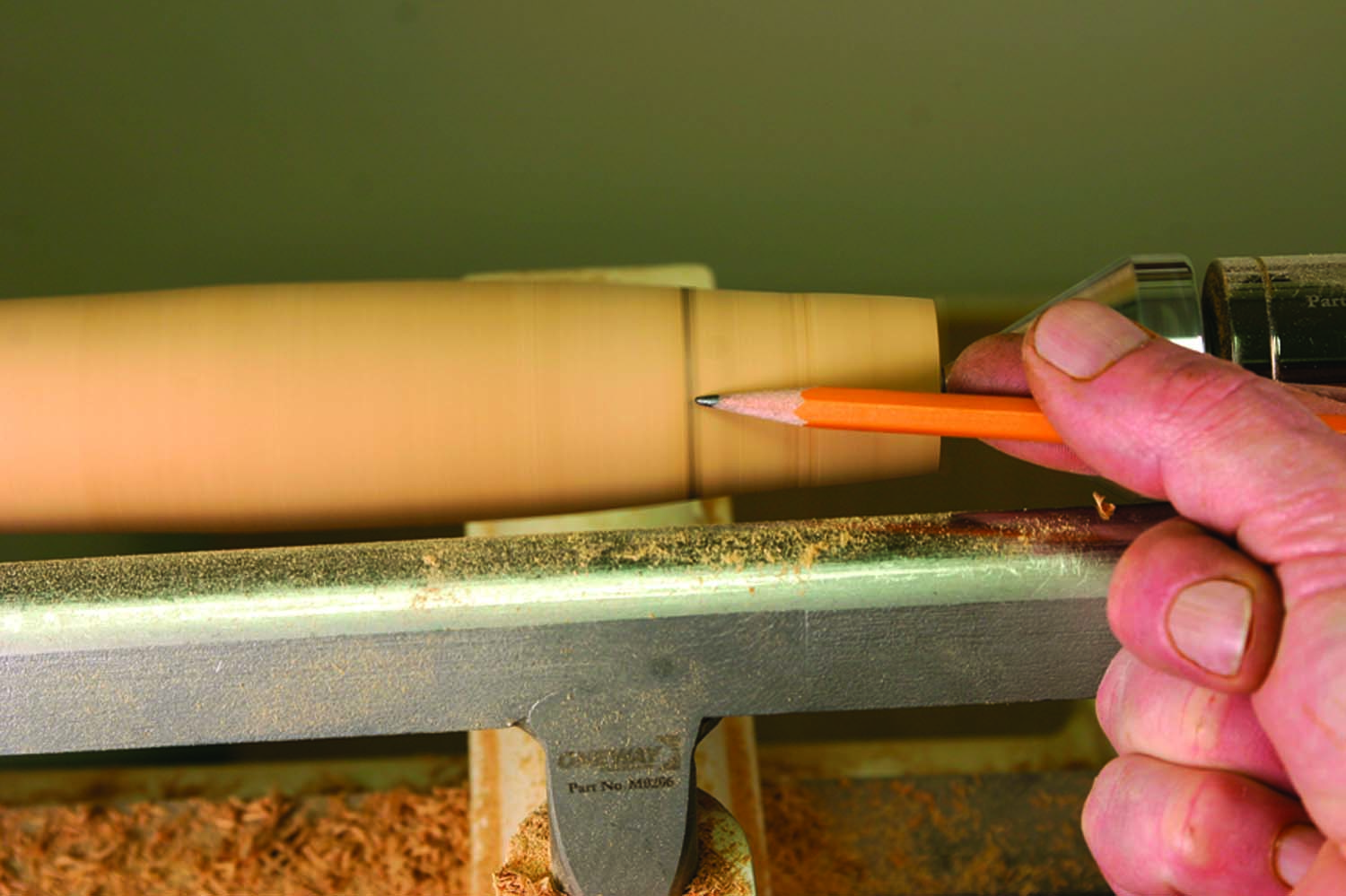
Room to grow. Leave some extra room to fit the taper. You will need to adjust the angle and the length as you fit the socket.
Turn a taper to roughly match the outside of the socket. There’s no need for a precise measurement here. The inside of the taper may not be the same angle as the outside anyway, so an approximation is all you need.
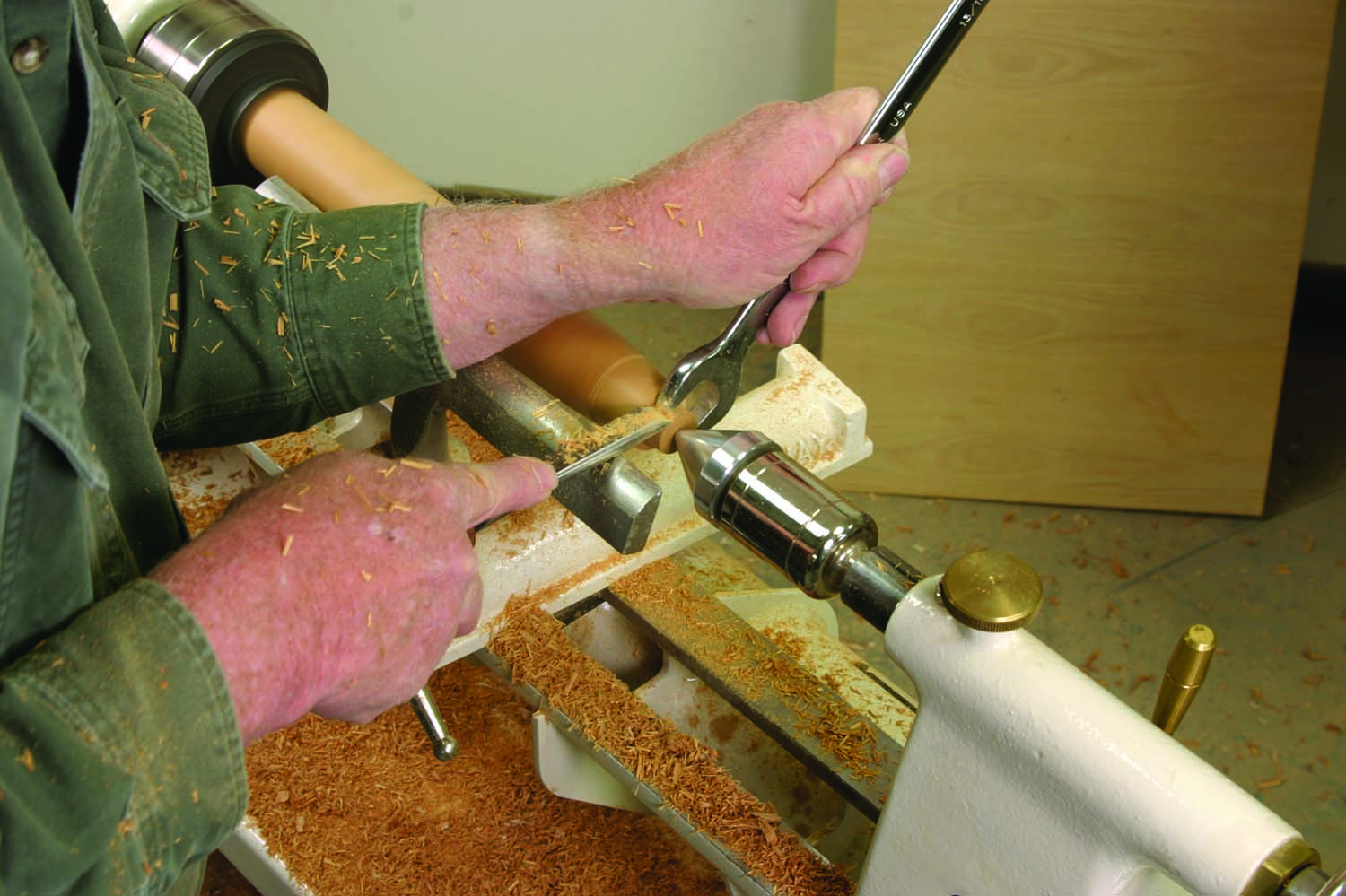
A clever answer. Then use the same wrench to tell you when you have reached the desired diameter.
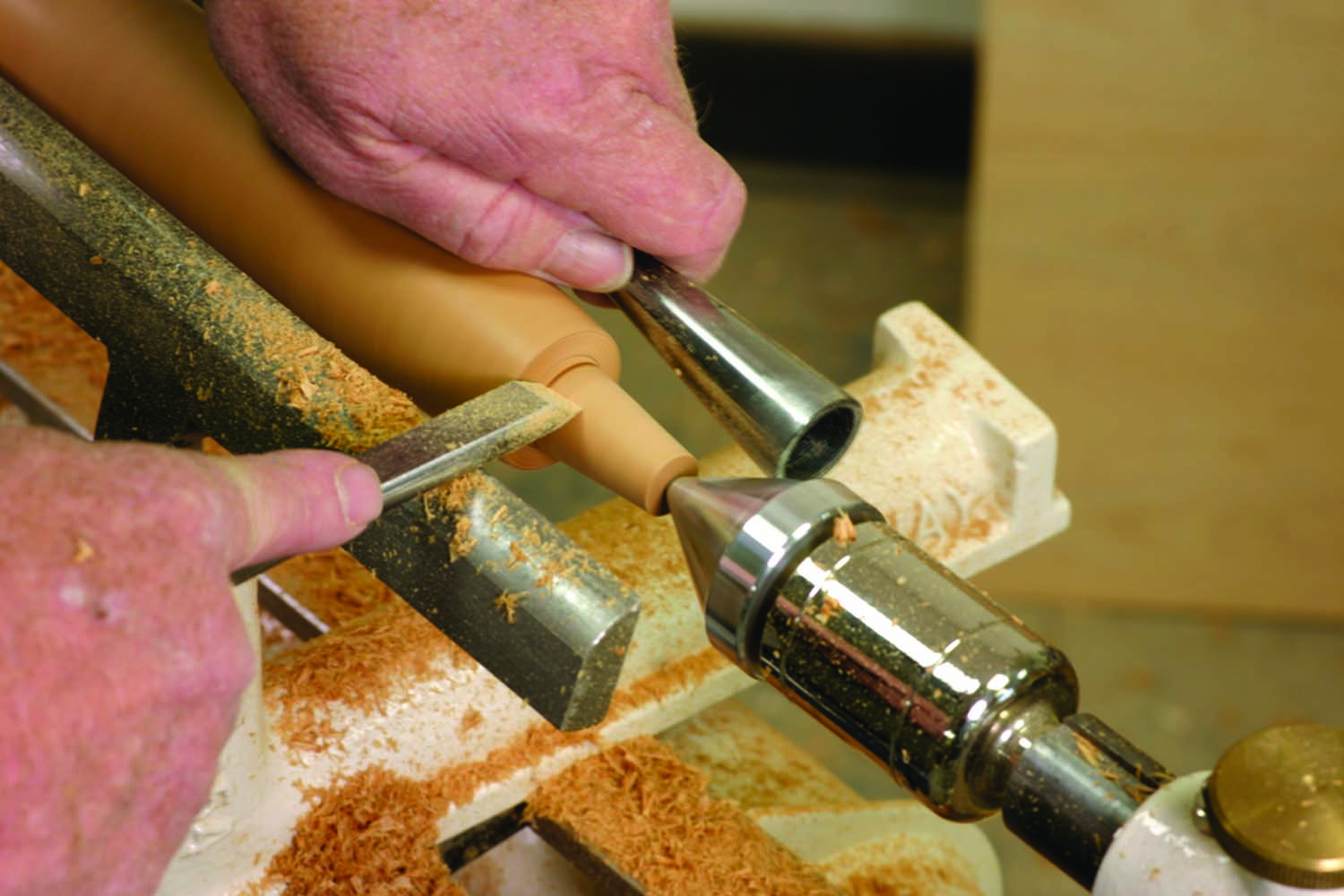
Let the socket be your guide. The inside taper may or may not match the outside. The socket held behind the work will get you close; you will fine-tune it later.
Fit the tapered tenon to the socket. If the handle is loose at the mouth of the socket, then increase the taper until it fits. If it’s tight at the mouth but wobbles, then decrease the taper. There should be a space between the shoulder of the tapered tenon and the top of the chisel when it fits to allow the handle to compress into the socket with time and use.
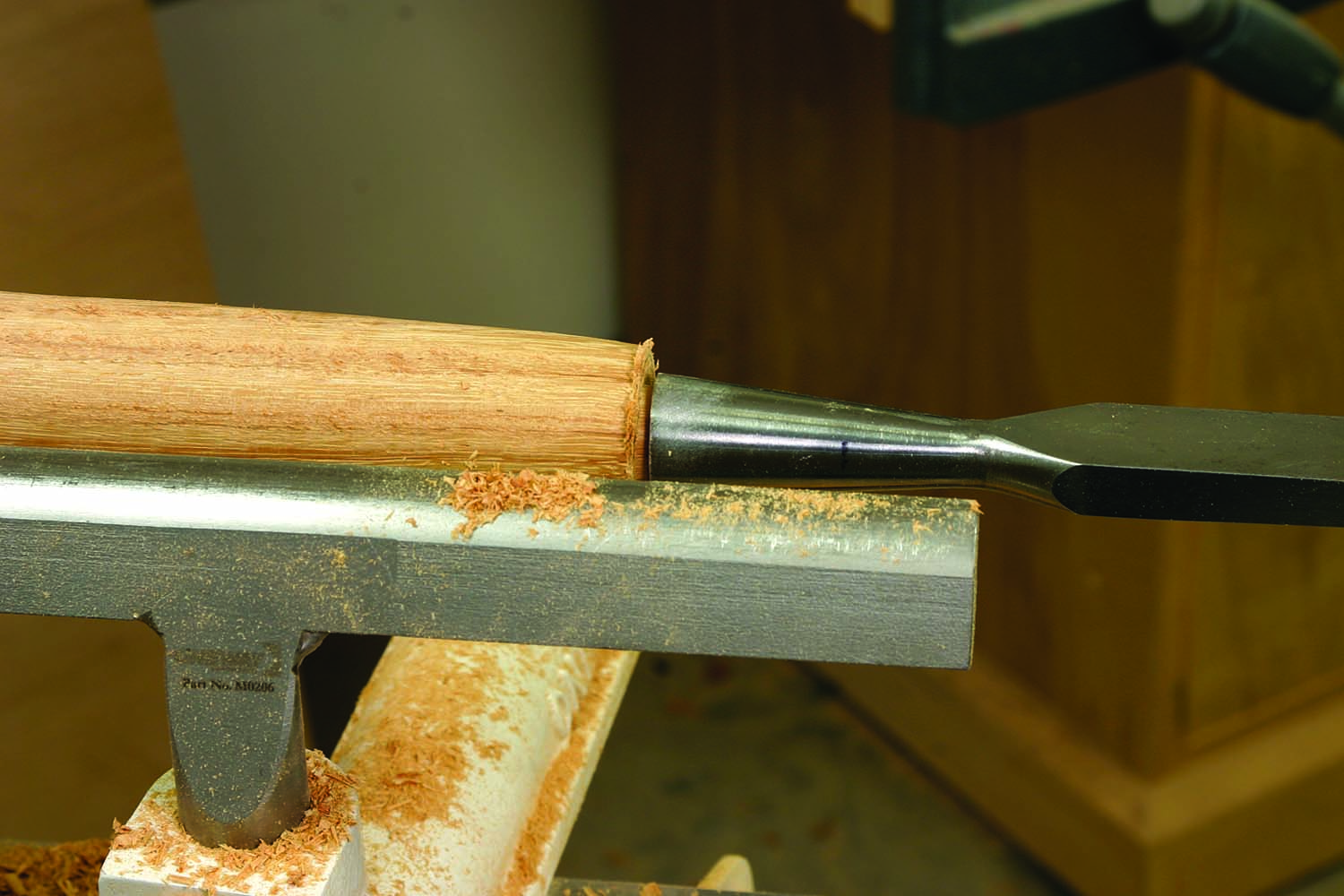
Room for compression. A small gap between the socket and the shoulder will keep the handle tight over time.
All you’ll need is about 1⁄16” – or a little more for really soft woods and a little less for really hard woods. Turn the blank to your preferred shape and drive it into the socket.
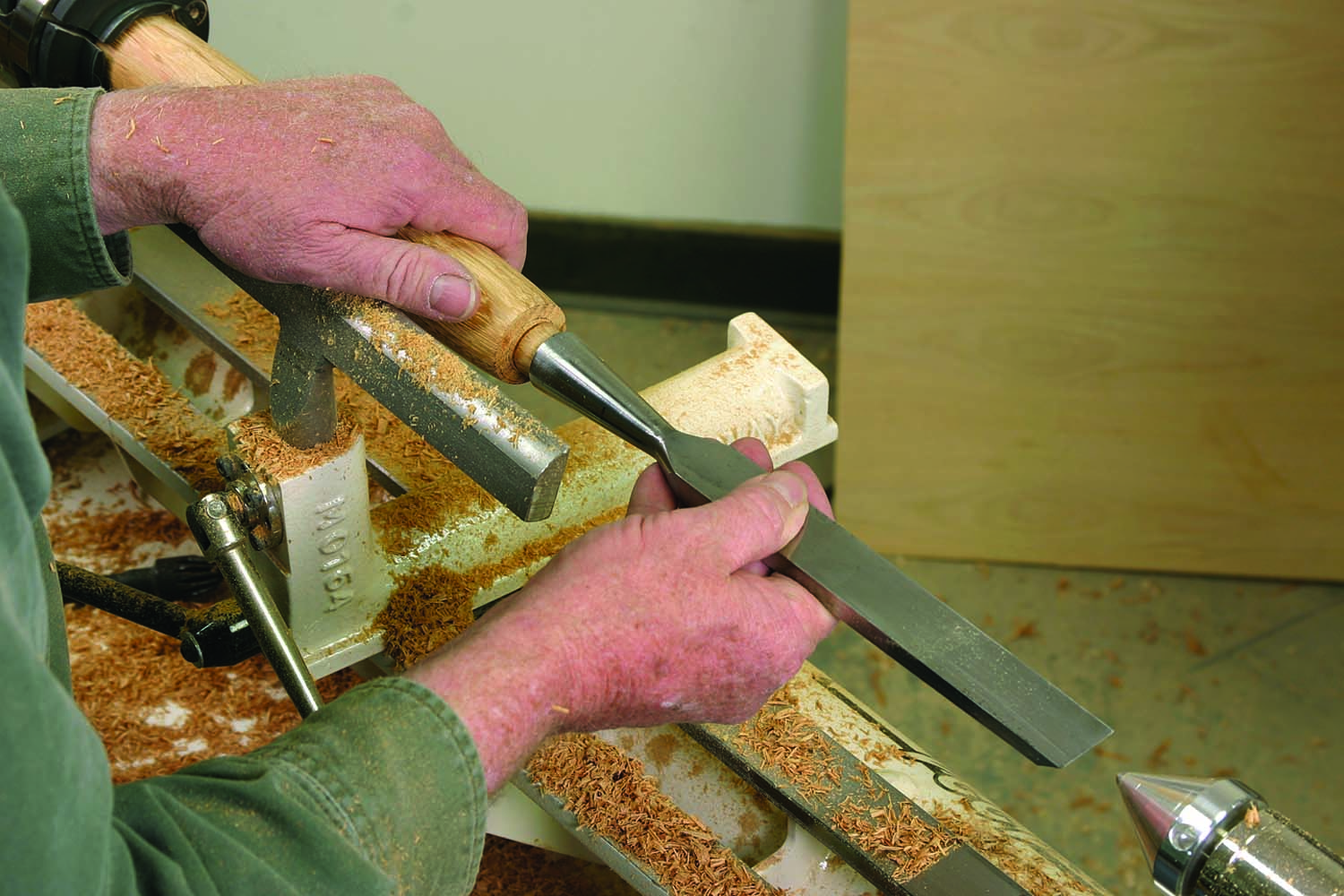
Check it out. A test-fit will tell you when the taper is correct.
Tang Handles
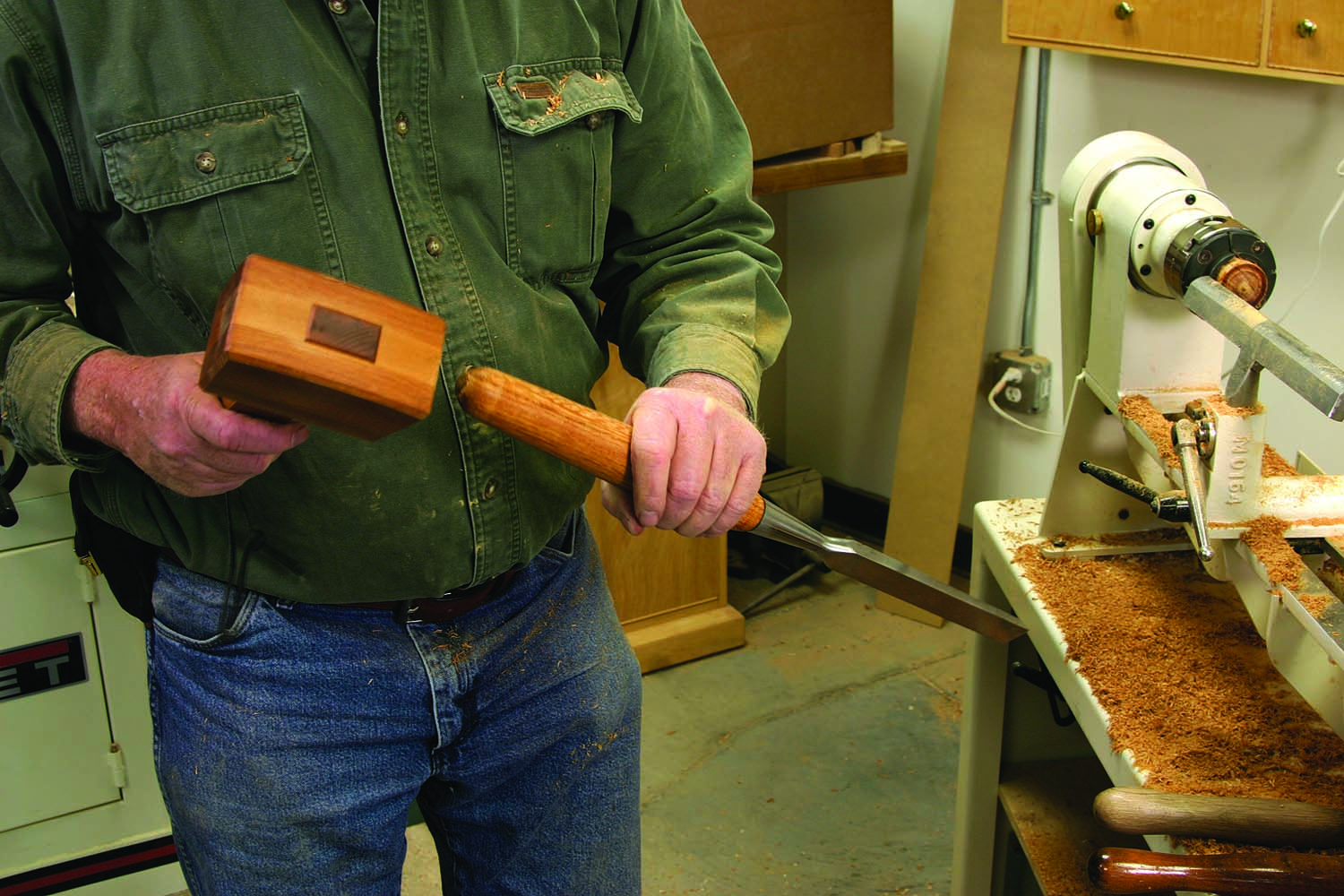
Drive it home. A few taps with a mallet will seat the handle in the socket.
Tang handles rely on the grip of the tang within the handle to secure them. Wooden handles are driven onto the tang of the blade, and the blades are expected to hold in much the same way a nail is expected to hold, only better. A tang can loosen over time though, and make for a wobbly handle – but a little epoxy can fix that.
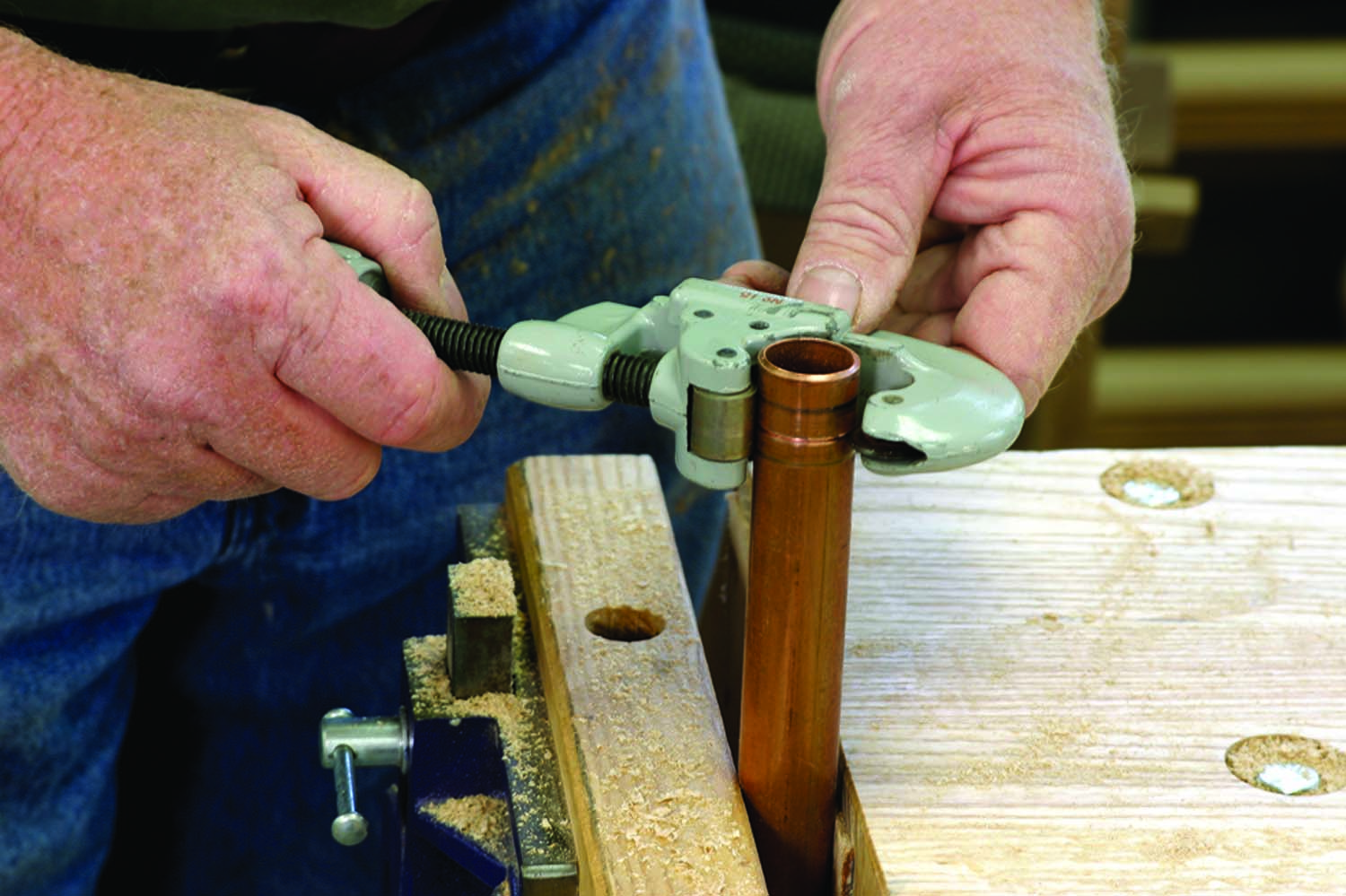
The right tool. An inexpensive pipe cutter makes a cut quickly and leaves smooth edges on the copper ferrule.
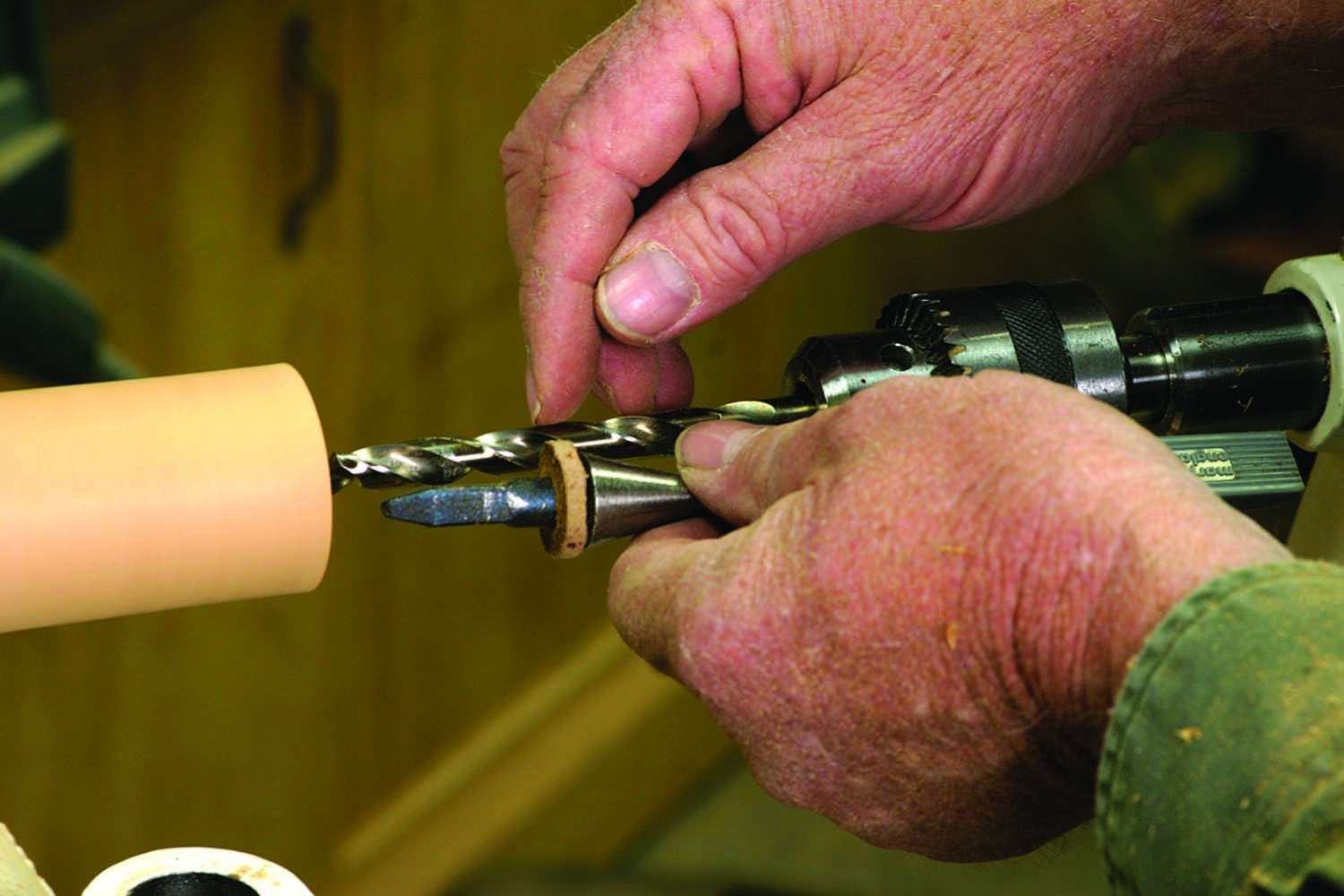
A matter of judgment. The depth of the hole should be somewhat deeper than the length of the tang. The end will be trimmed to fit.
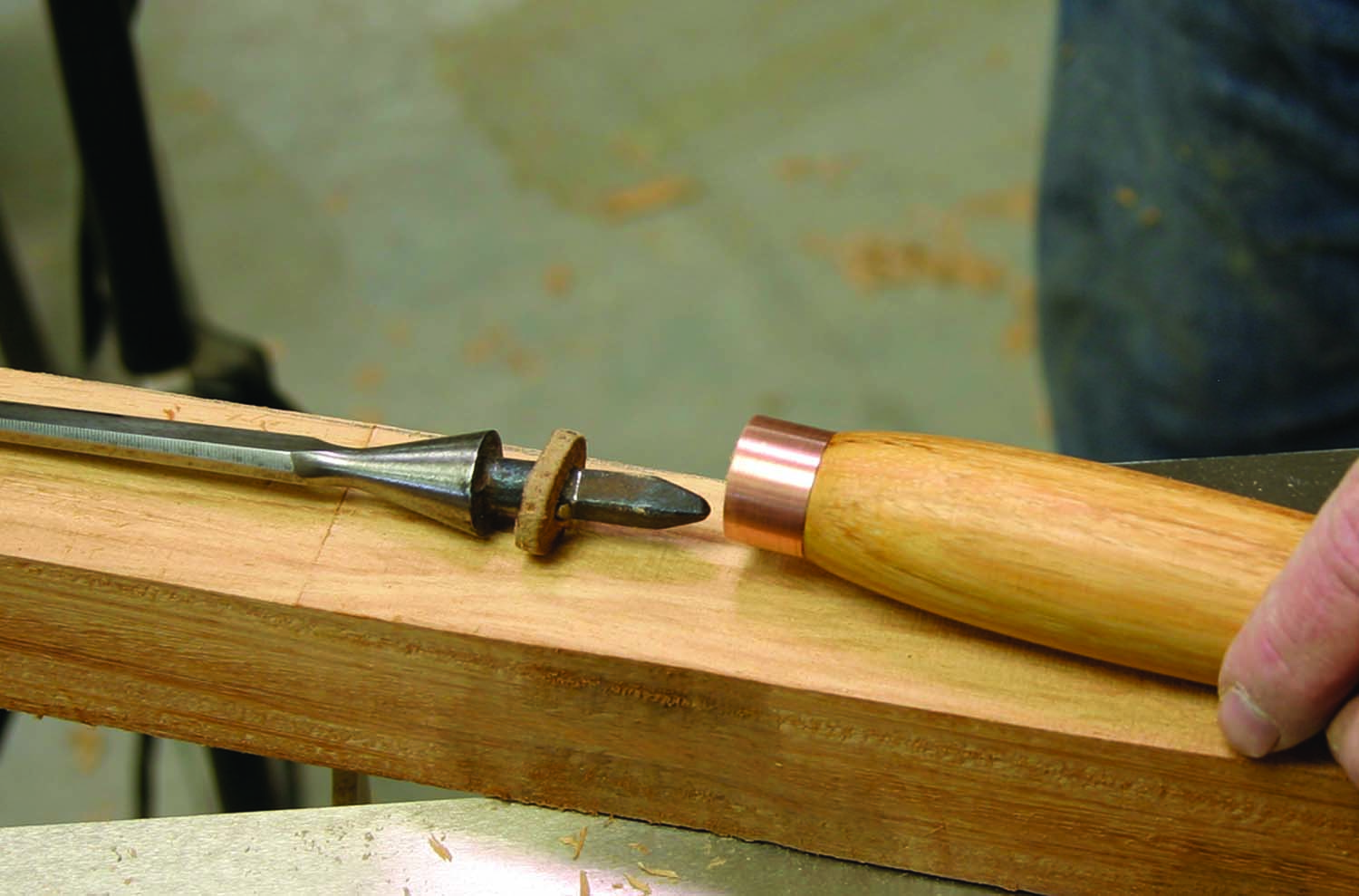
Beneath the plastic. Most plastic-handled chisels look like this inside. The ferrule keeps the handle from splitting, and a leather ring absorbs shock and fills the gap.
A ferrule is usually required to keep a wooden handle from splitting when it is driven onto the tang. Another option, and one I use for paring chisels and chisels that originally had molded plastic handles (they generally have cast round tangs instead of the more traditional tapered tang), is to make a hole in the handle that just fits over the tang, then fill the hole with epoxy just prior to installing the handle. This mitigates the need for a ferrule, which I don’t much care for on paring chisels. Plus when you are converting plastic-handled chisels to wood, driving on a round tang can be a problem.
As in socket handles, start with a blank that is a couple inches longer than your desired length. Once your blank has been rounded up, you will be gripping it with a four-jaw chuck to drill the tang hole and then finish the handle, so you will need some extra length for that.
Round up your blank, leaving it about 1⁄4” larger than the largest diameter on your preferred shape.
I prefer to drill the tang hole prior to mounting the ferrule. You will use the hole as a center once it’s drilled to ensure that the hole runs along the centerline of the handle. Replace your drive center with a four-jaw chuck and remount your blank. Spin it to check for alignment and take a rounding cut if you need to, then replace the tailstock center with a drill chuck.
For a round tang, use a bit that is slightly bigger than the diameter of the tang. Do some trial drilling on a piece of scrap to arrive at the bit you want to use. You will be adding epoxy to the hole for a round tang. For a square or rectangular tang use a bit that is just smaller than the diagonal distance from corner to corner to create a friction fit (a square peg in a round hole).
For a tapered tang, use a bit that is just larger than the tip of the tang. You can use a tapered reamer to taper the hole, or create a stepped hole with more than one bit. Trial and error on some scrap will get you a friction fit. Wait until the handle is finished before you use a reamer on the hole.
Spin the blank and crank or push the tailstock into the end to drill the hole. Be sure to occasionally back the bit out to clear the chips to avoid getting the bit jammed in the hole.
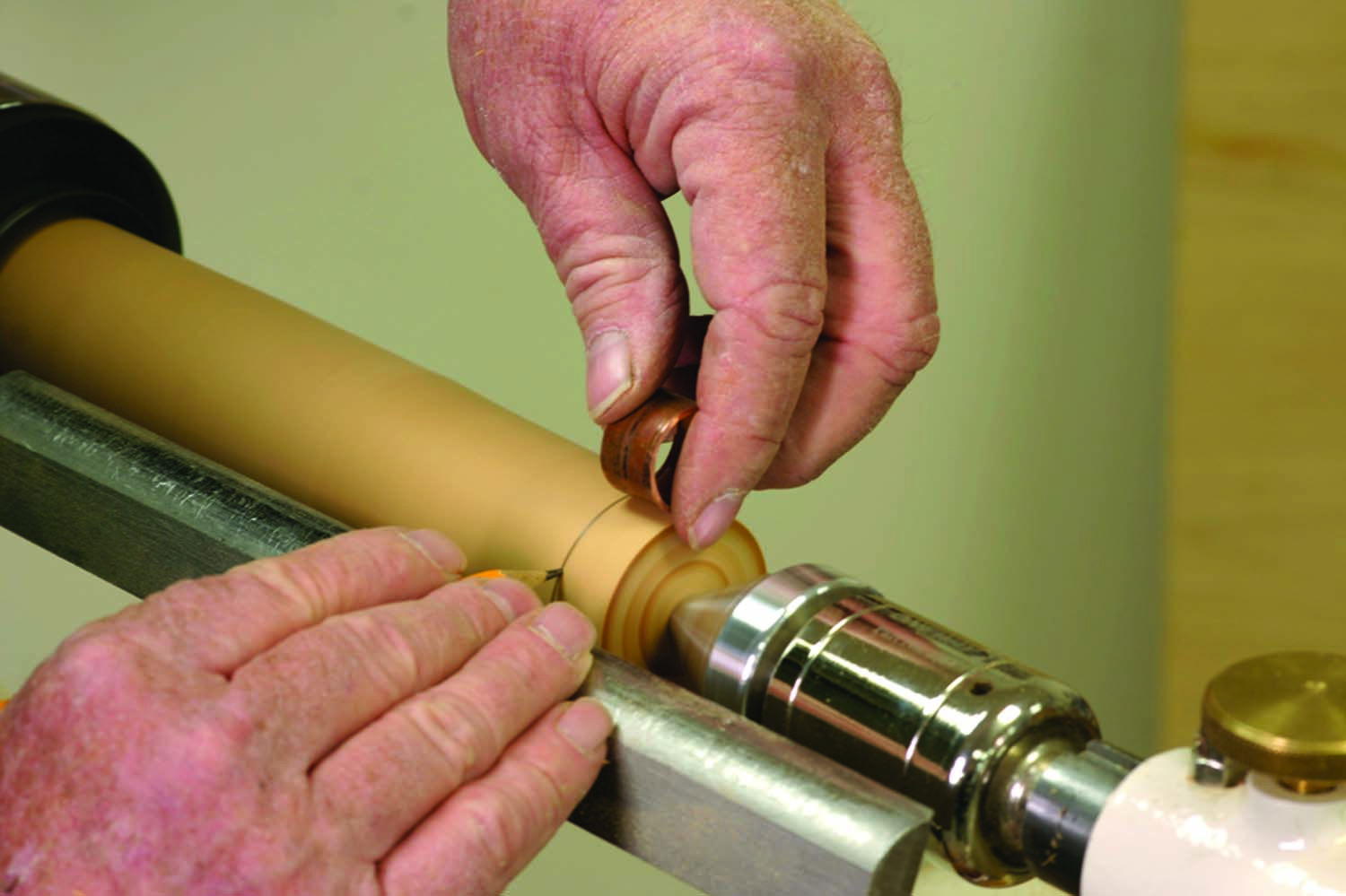
Be direct. The cone center fits in the tang hole, keeping the work centered. Use the ferrule to gauge the length of the turned tenon.
Now you are ready to fit the ferrule. With the tang hole drilled, remount the blank between centers. A cone-shaped live center in the tailstock is perfect for this. The cone will center the blank using the tang hole.
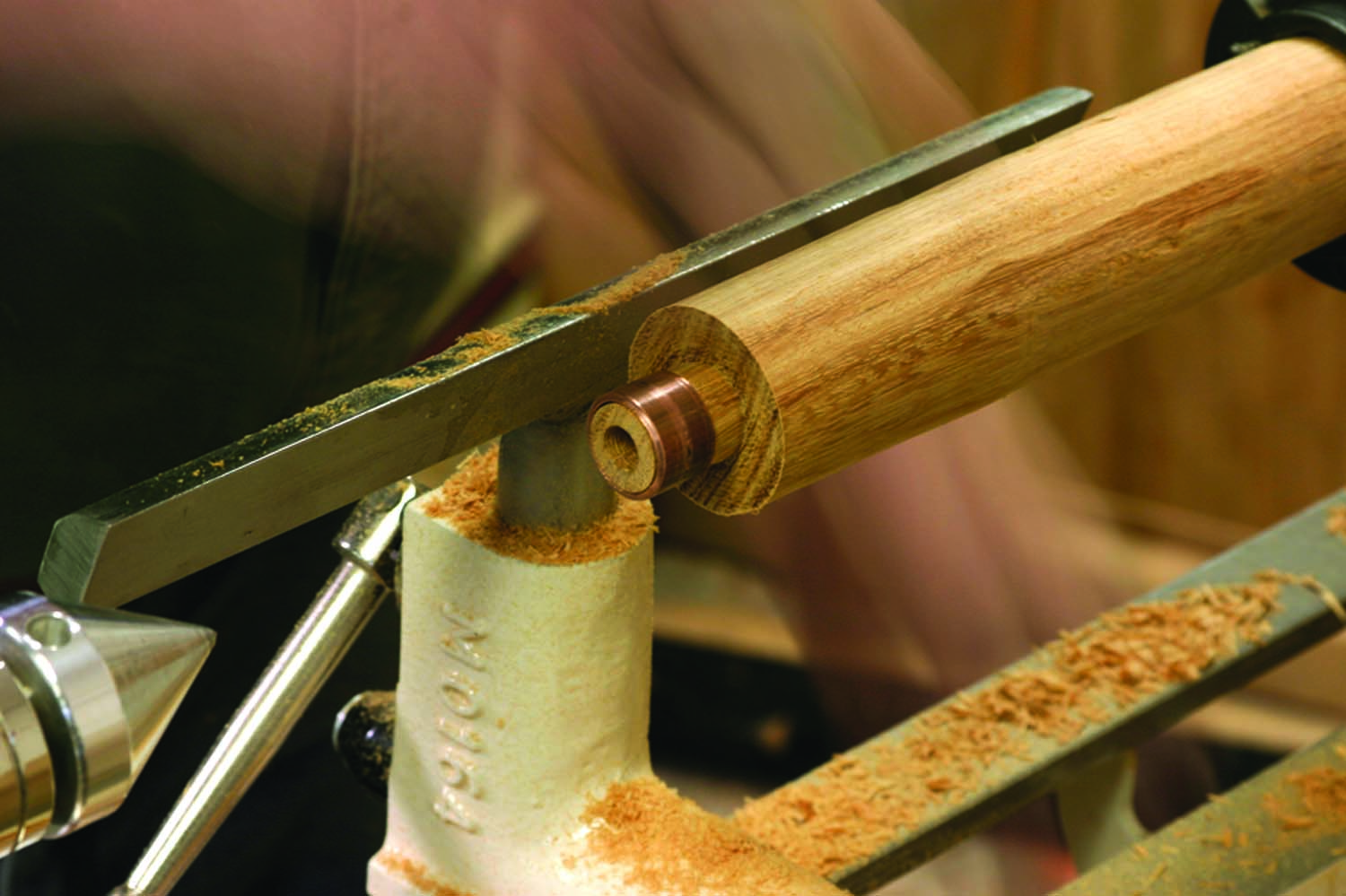
Almost home. Make a slight taper on the tenon, then test the fit of the ferrule.
I make my own ferrules by cutting short lengths from copper pipe. Gauge the length and the inside diameter of the ferrule and cut a tenon to fit the ferrule. Taper the tenon ever so slightly toward the handle. When you have a near fit, use a piece of pipe to drive the ferrule on the handle.
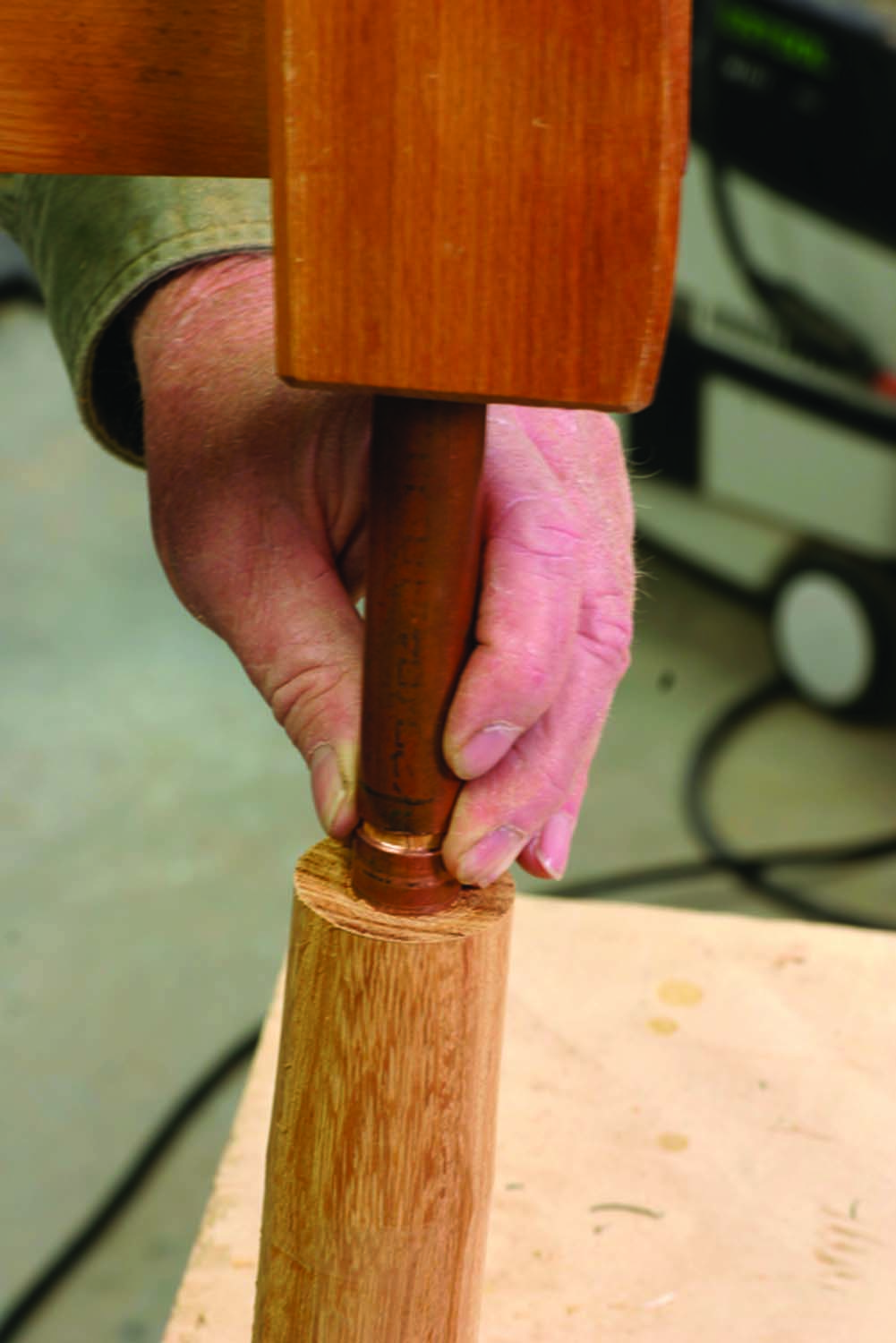
Tap it in. Use a length of pipe to drive the ferrule on to the end of the tenon. The ferrule will shave the last bit of the tenon for a snug fit.
Shape the handle using your preferred shape as a guide. Cut the end of the blank flush with the end of the ferrule, and taper the body of the handle down to the other end of the ferrule.
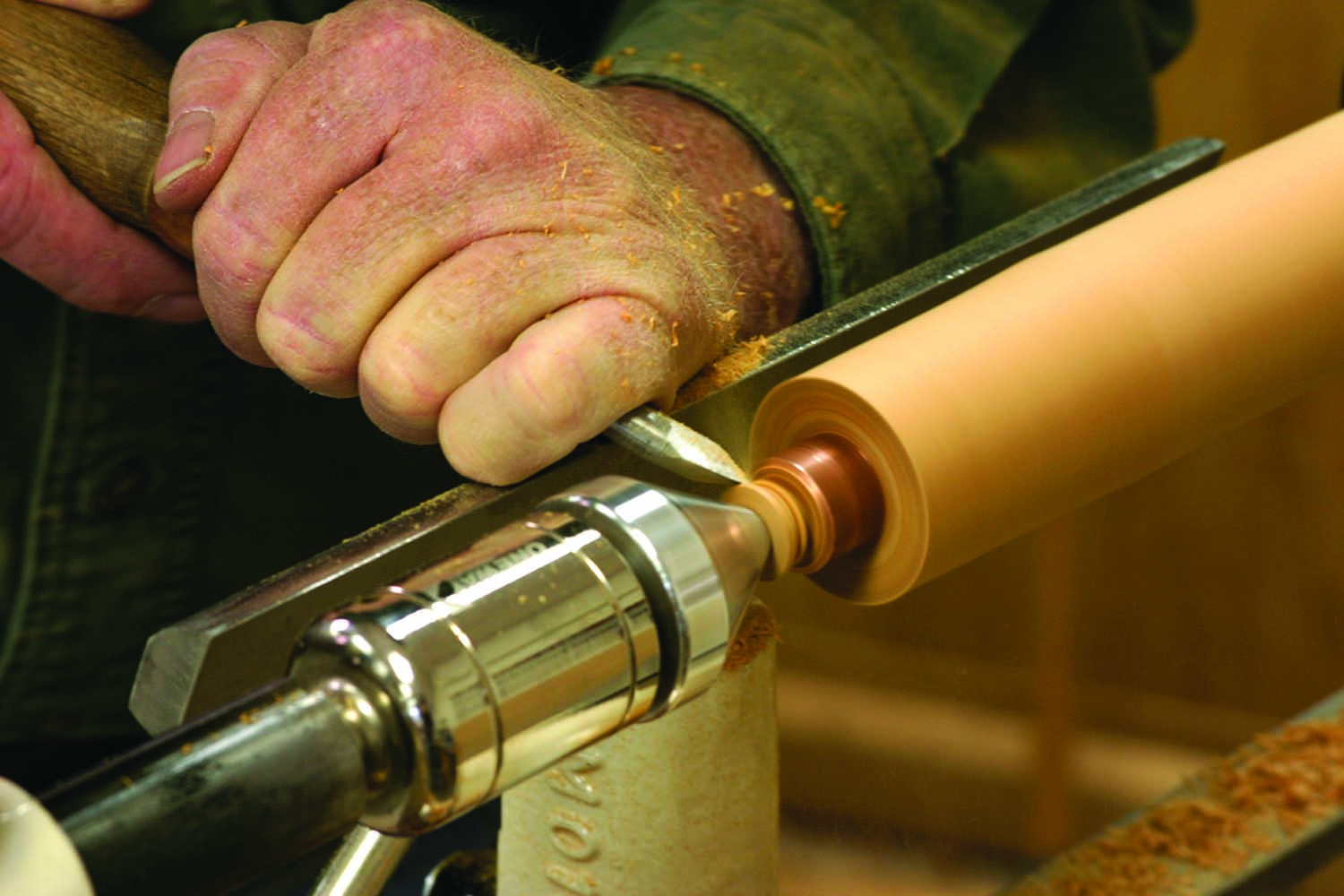
Make it flush. Remove the excess material beyond the ferrule, then move the cone center in.
For round tangs you will want to add some epoxy to the tang hole. The risk here is that the epoxy will create hydraulic pressure that will split the handle. Drill a tiny hole through the wall of the chisel into the tang hole. This hole relieves the pressure and will be sealed by the epoxy as it squeezes out.
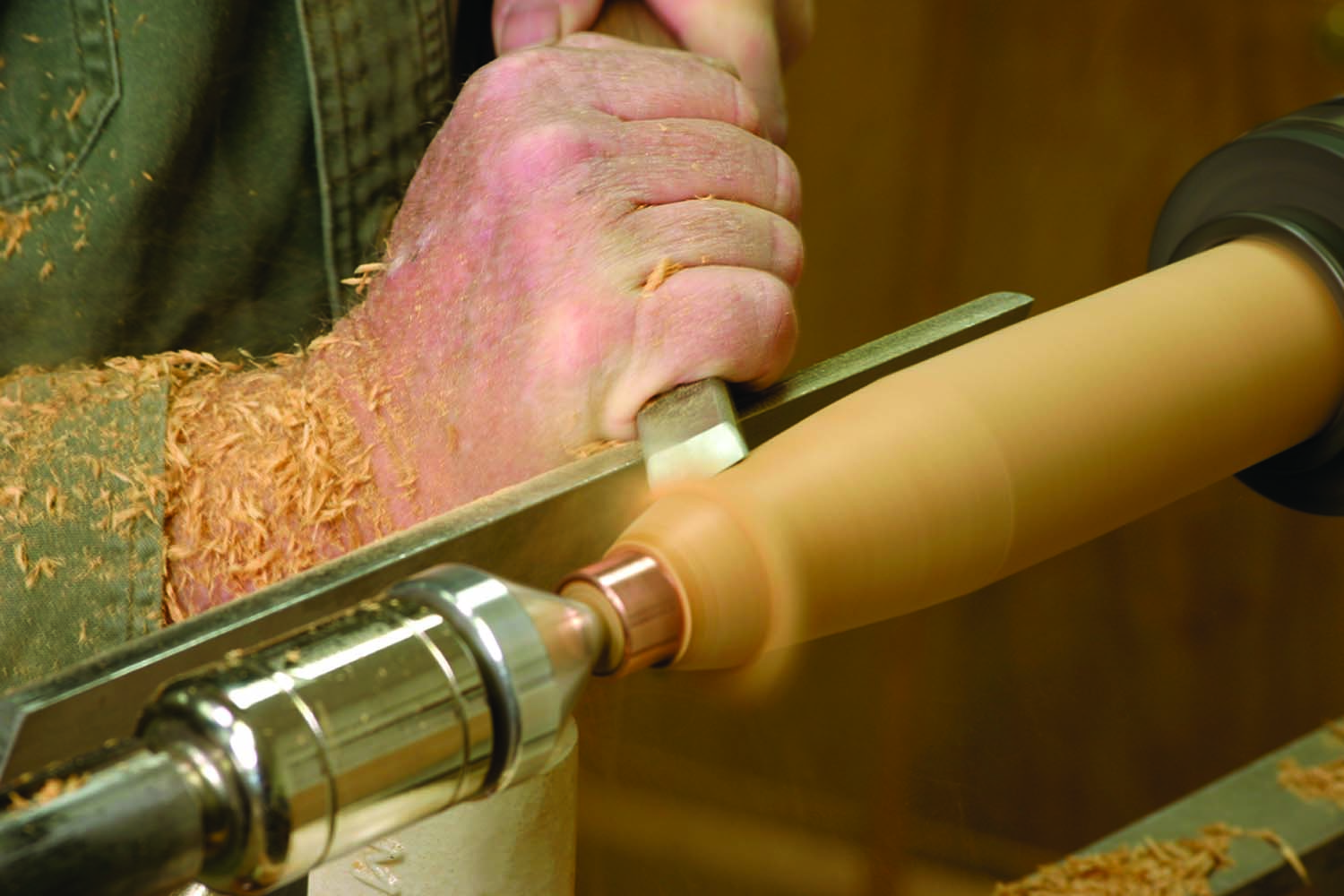
Shaping up. As the handle takes shape, carefully taper the end of the handle to the edge of the ferrule.
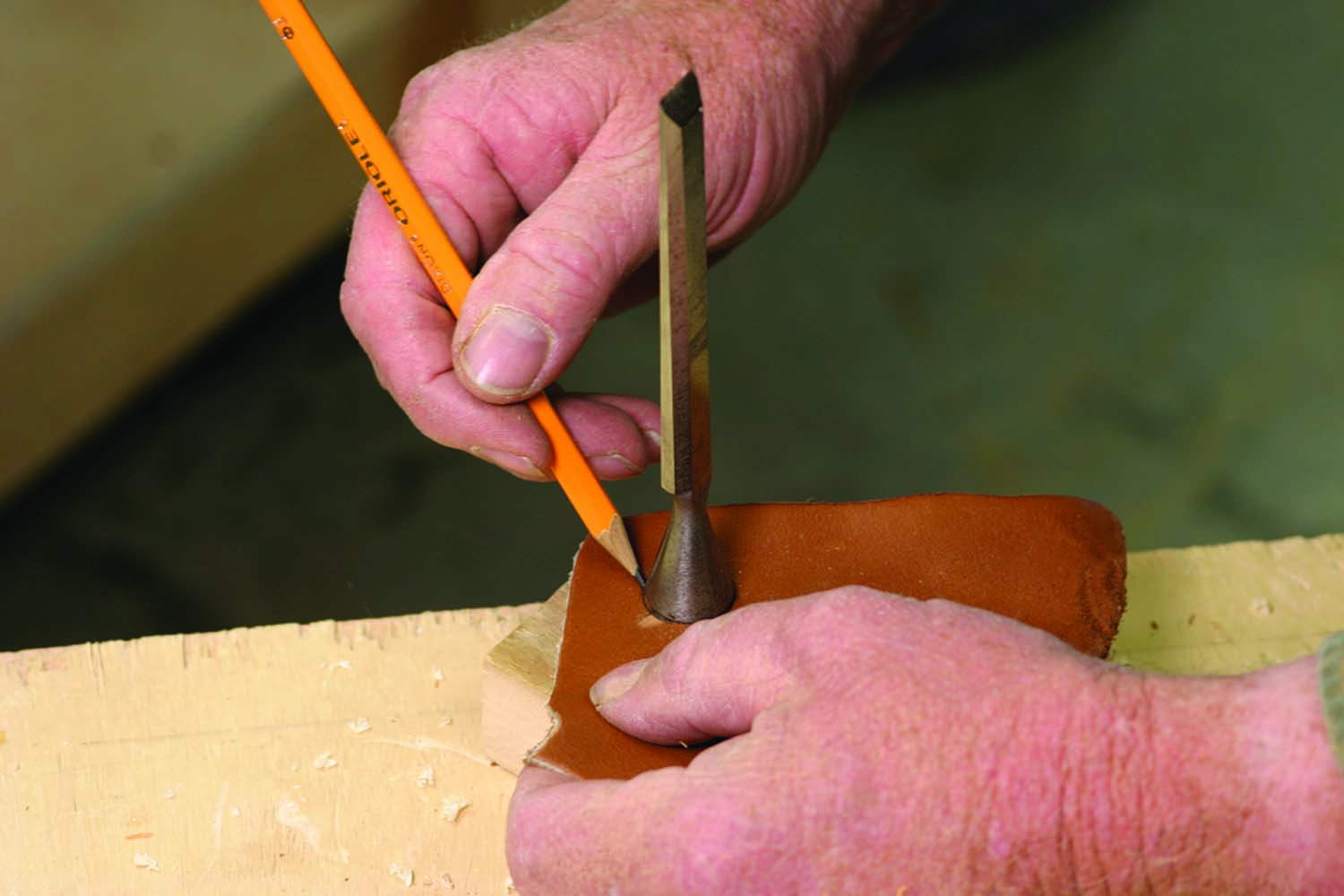
Drill then trim. Use a twist drill to make a hole in the leather, then trace around the taper before cutting the disc with scissors.
For square and rectangular tangs, insert the blade into the handle using hand pressure, then hold the handle and strike the end of it to continue seating the blade. Check and adjust the alignment between blows. Grinding any sharp corners off of the end of the tang can ease the installation.
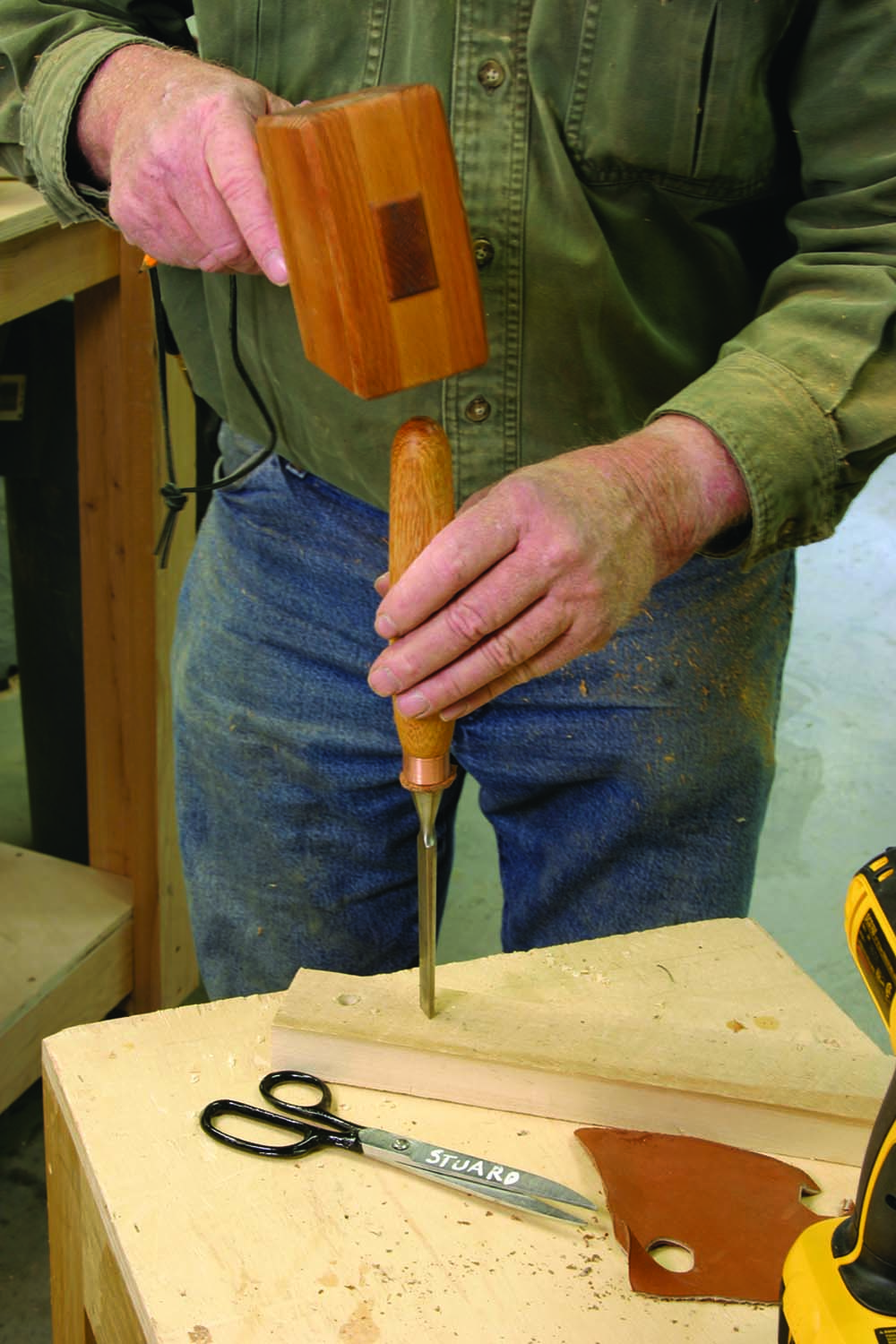
A dab will do ya. A small amount of epoxy in the hole will keep the tang connected. Place the leather over the tang and drive the handle on.
For tapered tangs, ream the tang hole to widen the mouth and seat the blade as you would a square or rectangular blade.
It only takes a few minutes to turn a tool handle once you get the hang of it, and the benefits accrue every time you pick up a tool that has a handle that fits … well … like a fine glove.
Kevin is a graduate of the Fine Woodworking program at the College of the Redwoods and the owner of Glen-Drake Toolworks, in Fort Bragg, Calif. You can get in touch with him at glen-drake.com.
Here are some supplies and tools we find essential in our everyday work around the shop. We may receive a commission from sales referred by our links; however, we have carefully selected these products for their usefulness and quality.








